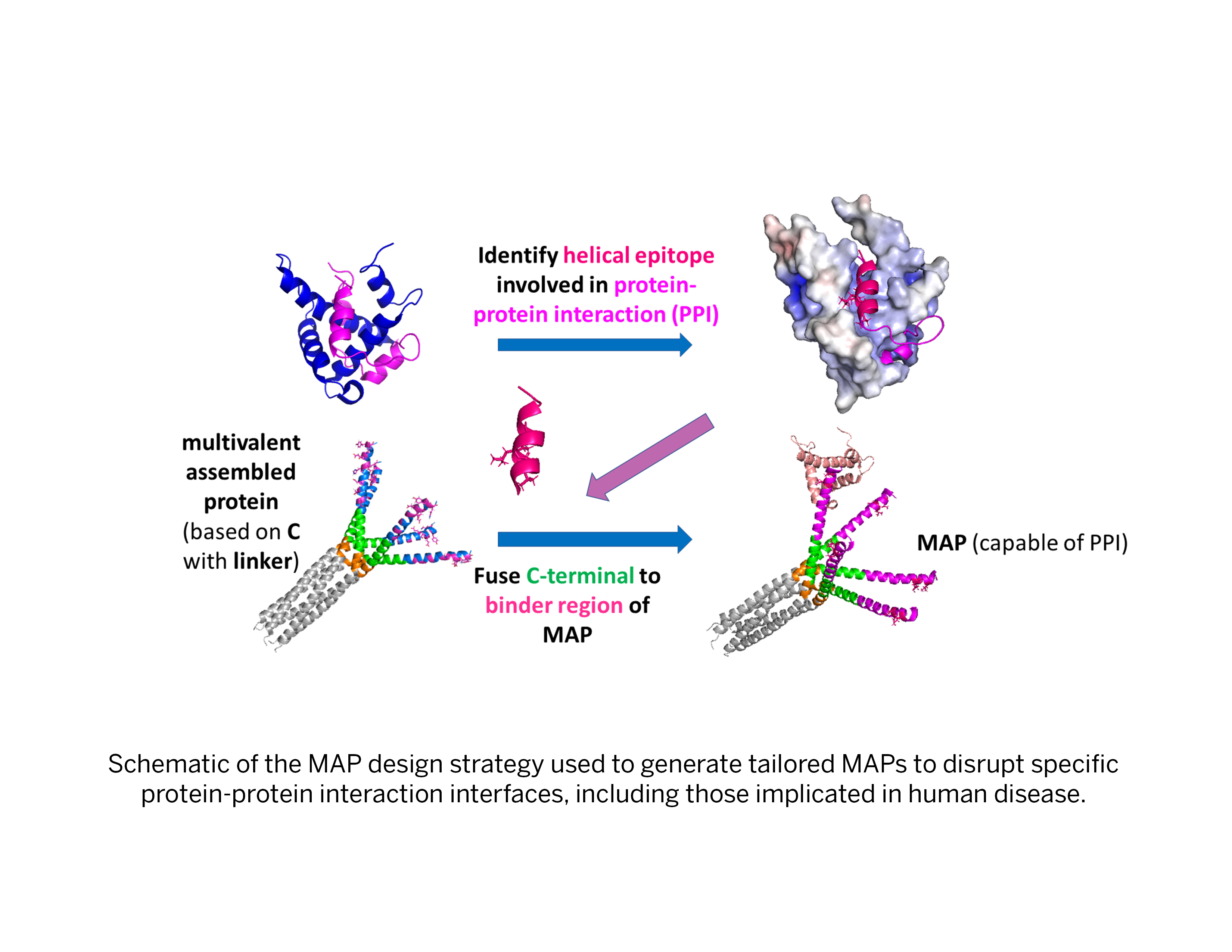Multivalent Assembled Proteins (MAPs): Therapeutics for Cancer and Infectious Diseases
Tailorable multivalent therapeutic for targeting difficult protein-protein interaction (PPI) interfaces in the context of cancer and infectious diseases

Technology
The Montclare Lab has engineered novel multivalent assembled proteins (MAPs), consisting of multiple (N+1) protein domain mimics (PDM) fused to a common oligomeric scaffold, as a promising therapeutic modality for the treatment of cancer and infectious diseases (see schematic on next page). In one such example, in published proof-of-concept work (Britton et al. Biochem Eng J 2022), the research team developed a MAP (termed “ACE-MAP”) to block the protein-protein interaction (PPI) interface between human angiotensin-converting enzyme (ACE2) receptor and the spike protein receptor binding domain (RBD) of SARS-CoV-2 that mediates coronavirus infections. ACE-MAP consists of five ACE2 PDMs each connected by a flexible peptide linker sequence to a subunit of a homo-pentameric central scaffold protein; specifically, the coiled-coil domain of cartilage oligomeric matrix protein (“C protein”). This design allows for increased avidity and higher affinity to the SARS-CoV-2 RBD by leveraging the multivalency of C protein. In ELISA assays, the research team demonstrated ACE-MAP binds to the SARS-CoV-2 RBD with picomolar affinity (Kd =620 pM), 19-fold stronger than monomeric full-length ACE2. In viral neutralization assays (using the SARS-CoV-2 delta variant), ACE-MAP showed greater inhibition of virus infectivity than the monomeric ACE2 PDM. Moreover, ACE-MAP demonstrated high thermal stability and low immunogenicity. In a second example, as described in the issued patent, the group engineered a MAP (termed “H-MAP”) with a similar pentameric valency that targets the interaction between cancer-implicated Hypoxia-inducible factor-1 alpha (HIF-1α) and p300. Taken together, ACE-MAP and H-MAP are promising early-stage therapeutic candidates for coronavirus infections and HIF-1α-driven cancers, respectively, due to their enhanced target binding abilities and concomitant high specificities.
Development Status
H-MAP has been evaluated in vivo using a 4T1 triple negative breast cancer xenograft mouse model. To facilitate tracking, H-MAP was conjugated to a fluorescence tag (Vivotag) and compared to a similarly labeled COMPcc scaffold. Significant ex vivo fluorescence from low H-MAP doses was observed in the tumor, liver, and kidneys, and side-by-side comparison to the control, revealed an increased relative fluorescence for H-MAP. In all, these in vivo studies highlight the clinical applicability of MAPs, and specifically demonstrate H-MAP’s potential as a therapeutic and/or diagnostic owing to its affinity for areas of increased local hypoxia.
Background
The Montclare Lab has extensive experience in protein engineering and exploiting naturally-occurring protein domains, such as the coiled-coil domain of cartilage oligomeric matrix protein (“C protein”), as scaffolds for creating next-generation, multivalent therapeutics or theranostics. HIF-1α is a regulator of cellular response to variations in oxygen concentration and is implicated in a variety of diseases with unmet need, such as cancer (hematological and solid), inflammatory disorders, and infectious diseases. With respect to oncology, HIF-1α is recognized as a promising therapeutic target for altering the energy metabolism in tumors, yet current HIF-1α inhibitors (e.g., acriflavine, PX-478, ganetespib) lack the sufficient binding affinity necessary to achieve high efficacy and limited off-target effects. HIF-1α is co-activated by the histone acetyltransferase p300, and the protein-protein interaction (PPI) interface between HIF-1α:p300 represents a tractable therapeutic target to block the pathological hypoxia response in tumors. To overcome the pitfalls observed with classical PPI inhibitors (e.g., suboptimal binding affinity, potency, and specificity), multivalent therapeutics can be engineered with multiple protein domain mimics (PDM), each used to disrupt a PPI, linked to a common oligomeric scaffold (such as C protein). The innovation described herein leverages the Montclare Lab expertise and offers a novel approach for using multivalent therapeutics to target challenging PPIs critical to tumor development and infection.
Applications
- For H-MAP: Treatment of cancers, such as leukemia, lung cancer, prostate cancer, colon cancer, and skin cancer
- For ACE-MAP: Treatment of coronavirus infections, likely including most known SARS-CoV-2 variants
- For MAP as a scaffold: Diseases and viral infections reliant on PPIs with alpha-helical epitopes, such as HIV and Parkinson’s Disease
- Tailorable research tool for studying PPIs such as the ACE: Spike RBD interaction and the HIF-1α:p300 interaction
Advantages
- Modular multivalent scaffold: MAPs based on C protein can be tailored with different PDMs to tackle challenging PPIs
- Enhanced binding affinity: The multivalency of MAPs leads to greater avidity and higher target affinity (picomolar range)
- Convenient, efficient, and relatively inexpensive production: MAPs can be expressed in standard bacterial expression systems (e.g., E.coli), affording high yields at relatively low costs
- High thermostability: ACE-MAP and H-MAP maintain structural integrity at elevated temperatures relative to monomeric controls
- Low immunogenicity: MAPs based on C protein likely have low immunogenicity since ACE-MAP did not elicit a significant immune response
Intellectual Property
NYU holds an issued U.S. non-provisional patent (received notice of allowance) covering the compositions of MAPs (such as ACE-MAP and H-MAP), their methods of use, and the potential applicability of ACE-MAP as a diagnostic.
-
expand_more mode_edit Authors (1)Jin Kim Montclare, PhD
-
expand_more library_books References (1)
- Britton D, Punia K, Mahmoudinobar F, Tada T, Jiang X, Renfrew PD, Bonneau R, Landau NR, Kong XP, Montclare JK. , Engineered multivalent self-assembled binder protein against SARS-CoV-2 RBD
-
expand_more cloud_download Supporting documents (2)Product brochureMultivalent Assembled Proteins (MAPs): Therapeutics for Cancer and Infectious Diseases.pdfMarketing BriefNYU-Therapeutic Multivalent Assembled Proteins-MON02-11.pdf (138 KB)